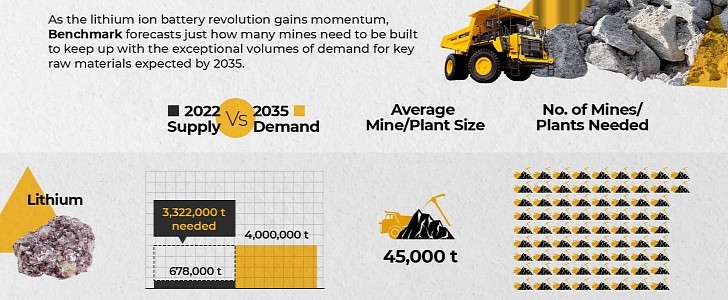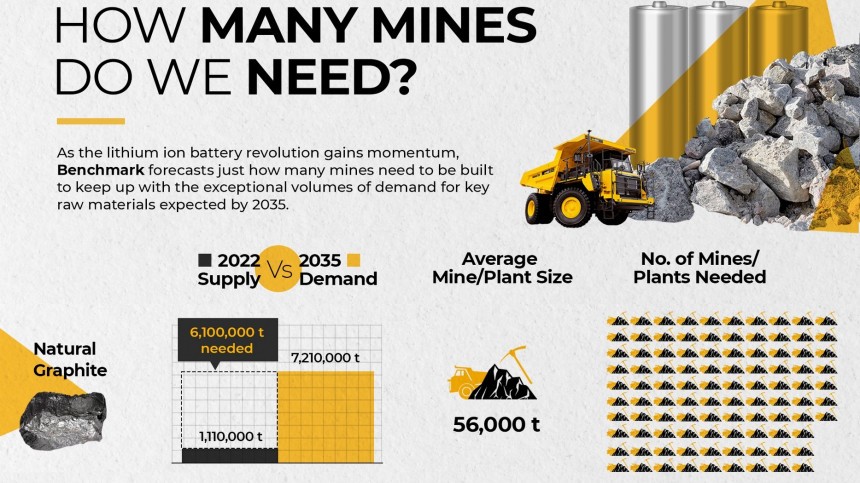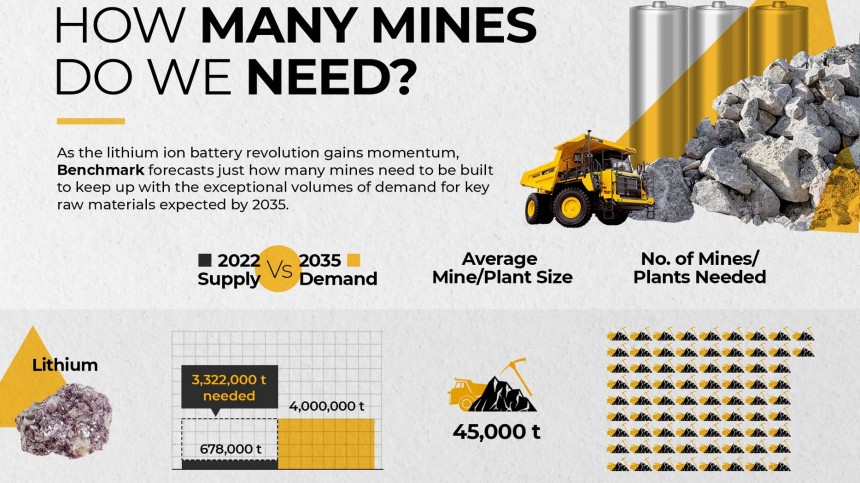Electric cars face more challenges in becoming mainstream than those with combustion engines. Although the supply chain crisis is something they share, EVs still need a charging infrastructure that works and to lower their battery packs’ prices. That will only happen with more raw materials, so they also get more affordable. Benchmark Mineral Intelligence (BMI) calculated how many more mines we will need to meet the 2035 demand for electric cars, and the number is impressive: 359.
As you may imagine, not all mines have the same production potential. This is why BMI made its calculations based on annual production averages for each of the necessary mines lithium-ion cell manufacturing requires. According to the company, a lithium mine delivers an average of 45,000 metric tons per year. At that production level, the world would demand 74 new mines by 2035, for a total production of 3,3 million metric tons. That will complement our current production capacity for the 4 million metric tons of lithium EVs will need by 2035.
BMI calculates that 489,000 metric tons of cobalt are required by the same year. Considering current mines deliver 177,000 metric tons of the metal, we will need 312,000 metric tons more. As BMI established that a cobalt mine produces an annual average of 5,000 metric tons, we are talking about 62 new cobalt mines in 13 years. There’s a difference of 2,000 metric tons from the 310,000 metric tons these mines could produce, but BMI preferred to consider these new mines would be enough.
Nickel is one of the most relevant components in lithium-ion cells after lithium. It helps to improve the energy density of batteries. The current world production of this metal is 3.16 million metric tons. However, EVs will demand 6.2 million metric tons by 2035, which means we will need 3.04 million metric tons more. According to BMI, each nickel mine produces an average of 42,000 metric tons. The world will require 72 new nickel mines to reach the necessary production capacity. Perhaps at least one more, as the 72 mines would produce 3.02 million metric tons of the metal.
Graphite can be obtained in natural and synthetic forms. Natural graphite is less expensive but also presents a lower quality. The artificial variation comes from amorphous carbon materials obtained from petroleum, coal, or wild and synthetic organic materials. It is also the more suitable material for cells.
A mine for natural graphite usually produces around 56,000 metric tons of the component. EVs will demand 7.21 million metric tons annually, while the current production delivers 1.11 million metric tons. This mineral is the one that will require more new mines, according to the graphic BMI shared on Twitter: 97 units.
The issue is that this number does not match the need for 6.1 million metric tons of natural graphite. If 97 new mines produced 56,000 metric tons of the mineral each, they would deliver 5.432 million metric tons in total. To supply the missing 6.1 million metric tons of graphite until 2035 at the same individual production average, 109 new mines would be required.
We are not sure what BMI means by more synthetic graphite mines, but that probably relates to new petroleum fields or coal mines. Each production unit delivers an average of 57,000 metric tons, and the world’s current production is 2.1 million metric tons. EVs will require 5.2 million metric tons, or 3.1 million metric tons more than nowadays. This time, the BMI graphic matches our calculations: 54 more “mines” are necessary.
Summing up, the BMI graphic states we’ll need 359 new mines. Our calculations indicate the correct number is 371 new sites. A Québec website states that launching a mining project takes 10 to 15 years. An MIT document from 2011 says a mine can cost between $500 million to $1 billion. Current prices must be much higher. If they were the same, that would mean a massive investment of at least $179.5 billion.
There are many things that may change in the almost 13 years that separate us from 2035. We can have battery breakthroughs that make them lighter, we can discover new and affordable materials that will slash battery pack prices, or fuel cell vehicles may get the hydrogen network they need to flourish and become attractive to buyers.
Whatever the future holds, the need for more natural resources keeps us in the loop of asking for more than the planet can give – remember Earth Overshoot Day? While electric car efforts do not look at that aspect of manufacturing, the BMI estimates prove that these vehicles are just a different choice of environmental problems.
BMI calculates that 489,000 metric tons of cobalt are required by the same year. Considering current mines deliver 177,000 metric tons of the metal, we will need 312,000 metric tons more. As BMI established that a cobalt mine produces an annual average of 5,000 metric tons, we are talking about 62 new cobalt mines in 13 years. There’s a difference of 2,000 metric tons from the 310,000 metric tons these mines could produce, but BMI preferred to consider these new mines would be enough.
Graphite can be obtained in natural and synthetic forms. Natural graphite is less expensive but also presents a lower quality. The artificial variation comes from amorphous carbon materials obtained from petroleum, coal, or wild and synthetic organic materials. It is also the more suitable material for cells.
The issue is that this number does not match the need for 6.1 million metric tons of natural graphite. If 97 new mines produced 56,000 metric tons of the mineral each, they would deliver 5.432 million metric tons in total. To supply the missing 6.1 million metric tons of graphite until 2035 at the same individual production average, 109 new mines would be required.
We are not sure what BMI means by more synthetic graphite mines, but that probably relates to new petroleum fields or coal mines. Each production unit delivers an average of 57,000 metric tons, and the world’s current production is 2.1 million metric tons. EVs will require 5.2 million metric tons, or 3.1 million metric tons more than nowadays. This time, the BMI graphic matches our calculations: 54 more “mines” are necessary.
There are many things that may change in the almost 13 years that separate us from 2035. We can have battery breakthroughs that make them lighter, we can discover new and affordable materials that will slash battery pack prices, or fuel cell vehicles may get the hydrogen network they need to flourish and become attractive to buyers.
Whatever the future holds, the need for more natural resources keeps us in the loop of asking for more than the planet can give – remember Earth Overshoot Day? While electric car efforts do not look at that aspect of manufacturing, the BMI estimates prove that these vehicles are just a different choice of environmental problems.
More than 300 new mines could need to be built over the next decade to meet the demand for electric vehicle and energy storage batteries, according to a Benchmark forecast. https://t.co/QSJdcx3TD1 pic.twitter.com/vjm7t5ECqG
— Benchmark Mineral Intelligence (@benchmarkmin) September 6, 2022










